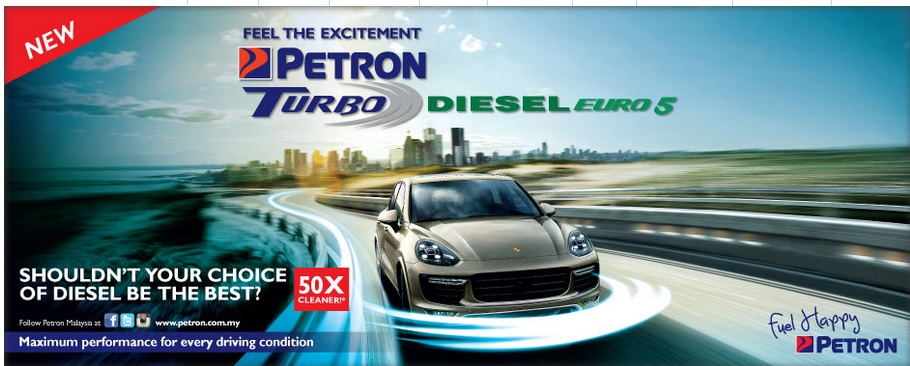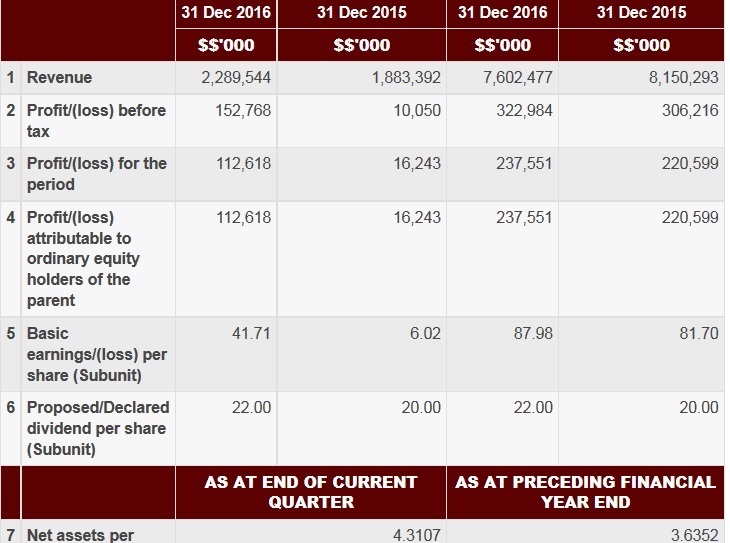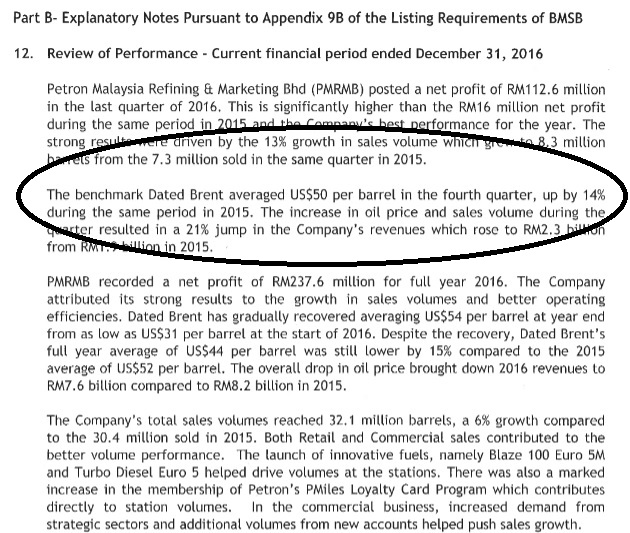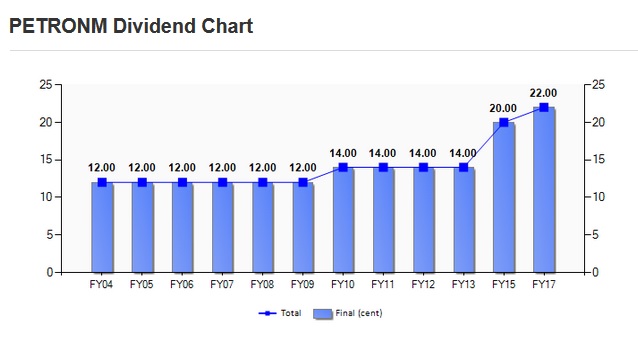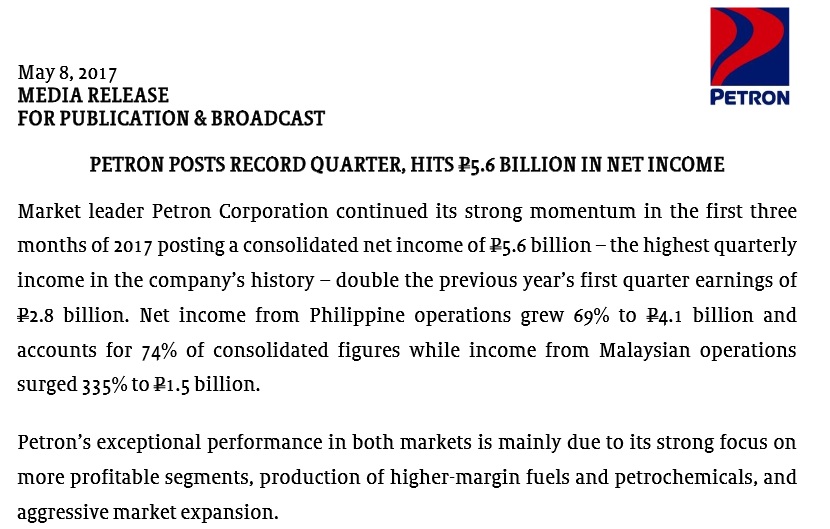Yesterday was Petron’s AGM but unfortunately I’m out of town. However, my nephew was there to attend on my behalf and so below are the notes in Q&A form he took down for me. Hope this would help shareholders who are not present and also appreciate if shareholders who are present can add on or correct if there are any missing or inaccurate points.
1. Retail market share
1Q15: 16.6%, 1Q16:17.4%, 1Q17:19%
2. Breakdown of gross profit
|
2016
|
2015
|
| Marketing margin |
418
|
321
|
| Refinery margin |
86
|
262
|
| Inventory gain/(loss) |
60
|
(49)
|
| Gross profit |
564
|
534
|
3. Reason for profit improvement in 2016?
Improvement in gross margin
4. Reasons for decrease in other income, increase in other operating income and decrease in other operating expenses
Lower realized forex hedging gain, higher service station license fee and higher deposits, lower realized forex losses
5. Factor of increase in sales volume
Expansion program, innovative products, customer service, promotions
6. Expansion plans
16 new stations so far this year, 23 completed and to be opened soon, target at least 50 for full year
7. RON100 and Turbo 5 sales
So far encouraging and they help in branding
8. Hedging policy
Commodity 40%, Forex 80-90%, the remaining natural hedge from exports
9. Capex plans
RM150m for 2017 to expand network and logistics and improve refinery efficiency
10. $1.5b expansion of refinery and new petrochemical plant
Still reviewing options, including debt and equity funding, will update shareholders once they have decided
11. Impact of weekly petrol pricing
No impact on profitability as retail petrol still under APM for gross profit of around 5c per litre (5c calculated based on refined product price), net profit depends from station to station
12. 1Q17 cost of sales increased by 15% while Brent only increased 8%, why?
Forex ringgit depreciation
13. Are the good performances sustainable? Is management confident of repeating the good results?
Volume and operating efficiency yes, marketing business is also doing very well
Margins are up to market forces, best if there is a stable market
Overall management is confident
14. High % held by Petron holding and plans to address public spread
Due to MGO last time. No plans for now
15. RPT with Petron Fuel International (PFI)
Buy and sell products with PFI. Depending on the distance between service stations and terminal, if Petron station is near to PFI terminal will buy petrol from PFI, vice versa
16. Fire incident
No effect on operations and supply, refinery operational again within a week. Have risk management, emergency response and business recovery plans when somehow preventive steps fail
17. Litigation case
Already won the case in Court of Appeal and Federal Court, plaintiff still not satisfied and appeal to Federal Court to review the decision, hearing on 24 Aug 2017.
18. Fair value instrument (pg 100 of AR)
Mark to market hedging instrument for commodity
Realised gains go into cost of sales, unrealized gains go to other income/expenses
19. Strong cashflow, higher dividend?
Petron Corp has 25% dividend policy but Petron Malaysia not subject to it. Will review annually and decide whether to have a policy and how much to pay shareholders
20. Is lower crude price beneficial to Petron Malaysia?
As downstream player, more concerned on margins
21. % of revenue from retail and commercial
70% retail, 30% commercial
22. LPG market share
12%
23. How are properties valued? Any revaluation?
Cost basis. No revaluation as it is costly and not Petron’s plan to profit from land appreciation
24. Is the refinery Euro-4 compliant and where is RON100 produced?
Already compliant, RON100 produced locally in Port Dickson
25. How much export sales
Very low less than 5%, only by-products
26. Out of 580 stations, how many owned by listed Petron?
55-60%, new expansions will also be around that %
27. Next mandatory shutdown date
2018
28. Refinery at full capacity, does Petron import from Philippines?
Refinery at 60% utilization, all sold for domestic, except by-product
29. Amortization of PPE
Leases and turnaround costs back in 2015. Lease amortised based on terms of lease, turnaround based on 3 years to the next maintenance
30. Why are there sister companies and how are RPT conducted?
All these date back to Exxonmobil times when Exxon and Mobil merged. Part of the anti trust provision is that both companies have to be segregated even though branding may be shared. So are Exxonmobil Malaysia before Petron Corp bought over. So nothing sinister and all RPT are conducted on arm’s length
My takeaway
1. Marketing/retail biz is doing very well
They are gaining market share and has robust expansion plans
2. No major capex in the near term
Only expansion of service stations and refinery efficiency improvement since refinery already Euro-4 compliant. RM150m capex plan shouldn’t eat much into its cashflow, so the company should achieve net cash by next quarter or at least end of the year
3. New plant expansion still premature
No details provided. If eventually it happens, most likely majority of funding will come from debt since they have a plant as security and the company has strong cashflows.
4. Main source of profit is not dependent on crude price
Dependent on the price differential/margin/crack spread
5. Number of petrol stations still room to grow
Now we know the listed Petron owns around 320-350 stations, the rest are by its sister companies. This may be relatively low compared to Shell around 900 or Petdag more than 1,000. But good thing is Petron is growing faster both in terms of number of stations and market share
6. No hanky panky with related companies
The explanation provided on why related companies exists and how they conduct RPT are perfectly understandable. And I don’t suspect that there are any transfer pricing issue between them
What I still do not understand
1. Breakdown of gross profit
Refinery profit is much lower in 2016. When I look at crack spreads data, it is lower in 2016 compared to 2015 but not that much lower. I suppose maybe we need to include inventory gain/loss together since crack spread already take into account your crude oil price. So maybe when crude price dropped in 2015, there’s inventory loss but refining gross profit benefited as a result. The opposite happen in 2016. Just a guess.
Meanwhile, it is weird when marketing/retail profit increased by 30% in 2016 when I don't think their volume grew that much. As Petron refine crude oil and pass it down to its stations or dealers before selling to final customers, I’m not sure how they classify between refinery and marketing profit. Maybe some of the refining gain is passed down to marketing?
2. Refinery apparently not at full capacity and they do not import
As pointed out by others, we understand that its refinery is not running at full capacity but initially we thought that it was by design and it is insufficient for them to cater to their local sales. However, it doesn’t seem like the case based on what they answered.
Summary
Overall, I’m quite happy with the info I got (I will give my nephew a big angpow next CNY).
The company gives me the impression that it is very well-run and is a growth company with ambitions to expand.
Unfortunately I don’t think I can claim to fully 100% understand the business. However with the new info, my investment case hasn’t changed. I still like Petron for its growing biz, stabilizing refining margins and strong free cashflow. Previously I expect RM1-1.20 EPS for 2017, this haven’t changed post results but probably I’m looking at the higher end rather than lower end.
Why am I so conservative? Because ultimately they are still in commodity biz and like what management guided, their profitability is still to a certain extent dependent on market forces. So I still treat 40c EPS a quarter as bonus but would still be perfectly happy for around 30c EPS each quarter. If it achieves RM1.20 EPS, it is trading at slightly less than 7 times PE.
Alternatively, I prefer to look at free cash flow. Using market cap/FCF may not be comprehensive as companies may have different capital structure, so I prefer EV/FCF. I compare the EV/FCF of Petron against Hengyuan, PetDag and another supposedly cashflow generating machine, Litrak. As some of you may know, cashflow sometimes may fluctuate over time so I took past 2 years plus latest quarter annualised and their average. With that I get this result which I think is pretty self-explanatory.
| Market cap | Cash | Debts | EV | FCF | EV/FCF |
| RM million | RM million | RM million | RM million | RM million | times |
| Hengyuan | | | | | | |
| 2015 | 1,491.00 | 175.52 | 1,481.05 | 3,147.58 | 685.36 | 4.59 |
| 2016 | 609.00 | 355.61 | 1,416.91 | 2,381.53 | (32.63) | (72.98) |
| 1Q17 | 1,743.00 | 339.72 | 1,414.01 | 3,496.73 | (46.14) | (75.78) |
| Average | | | | 3,008.61 | 202.19 | 14.88 |
| | | | | | |
| PetDag | | | | | | |
| 2015 | 24,685.98 | (1,291.27) | 211.82 | 23,606.53 | 344.72 | 68.48 |
| 2016 | 23,633.40 | (2,431.64) | 118.77 | 21,320.53 | 1,856.72 | 11.48 |
| 1Q17 | 24,030.60 | (2,323.68) | 104.98 | 21,811.91 | 818.15 | 26.66 |
| Average | | | | 22,246.32 | 1,006.53 | 22.10 |
| | | | | | |
| Litrak | | | | | | |
| 2015 | 2,635.00 | (334.64) | 1,283.00 | 3,583.36 | 257.36 | 13.92 |
| 2016 | 3,098.76 | (424.45) | 1,291.39 | 3,965.69 | 242.20 | 16.37 |
| 1Q17 | 3,109.30 | (552.65) | 1,229.71 | 3,786.36 | 387.01 | 9.78 |
| Average | | | | 3,778.47 | 295.52 | 12.79 |
| | | | | | |
| Petron | | | | | | |
| 2015 | 1,350.00 | (159.27) | 543.82 | 1,734.55 | 249.73 | 6.95 |
| 2016 | 1,120.50 | (171.64) | 307.96 | 1,256.82 | 302.64 | 4.15 |
| 1Q17 | 2,211.30 | (204.84) | 251.49 | 2,257.95 | 359.09 | 6.29 |
| Average | | | | 1,749.77 | 303.82 | 5.76 |
If Petron trades at 10 times EV/FCF (similar to Litrak but still below its average), EV should be RM3.6b. Excluding net debt, market cap should be around RM3.5b or roughly RM13!
With stable margins, growing retail biz (more than 300 petrol stations and counting), strong free cashflow of >RM300m a year, strong balance sheet (turning net cash soon), does it deserve to trade at current valuation?
I will leave it to market to decide
Lastly, again a share of some crack spread data
2Q17 vs 1Q17 vs 4Q16
Tapis: 8.50/8.47/6.78
Minas:11.95/11.95/11.03
Gulf: 12.91/11.96/10.61
Northwest: 11.59/9.50/9.42
Happy investing
Jay













